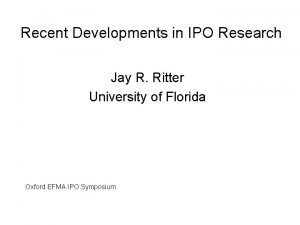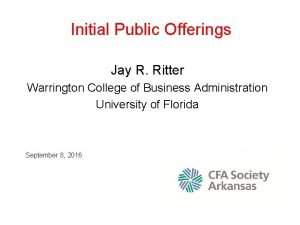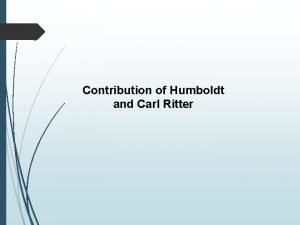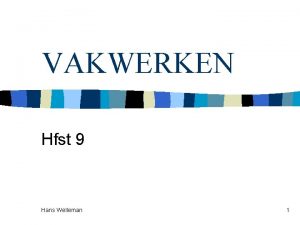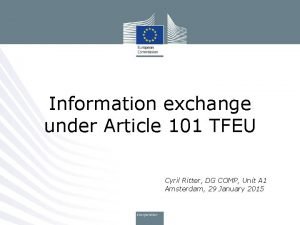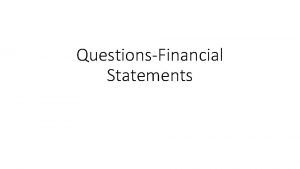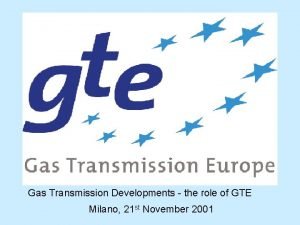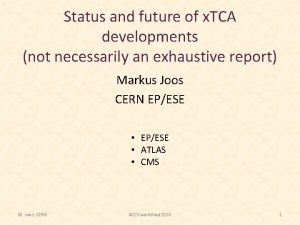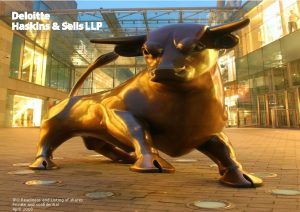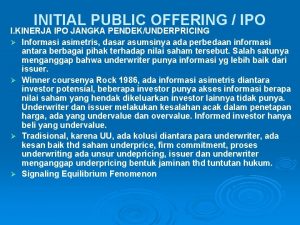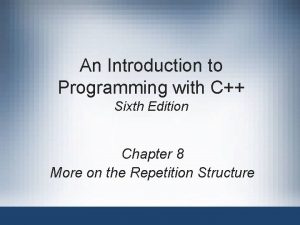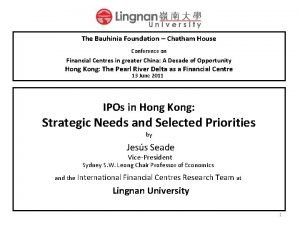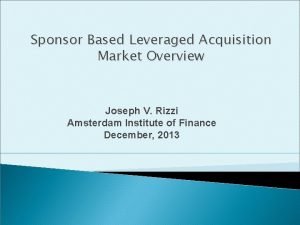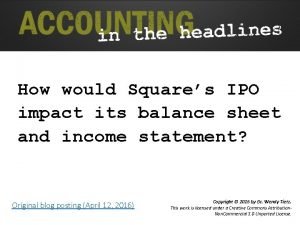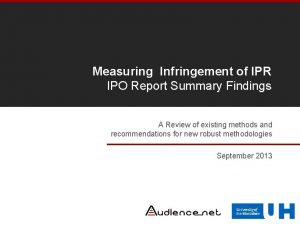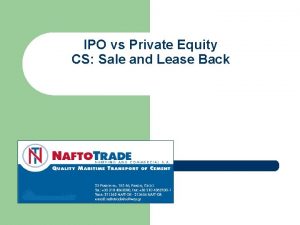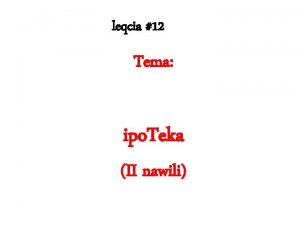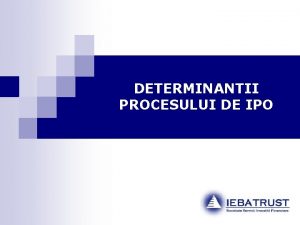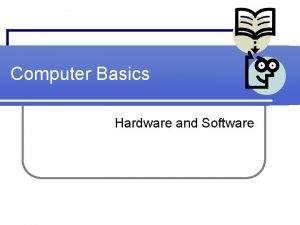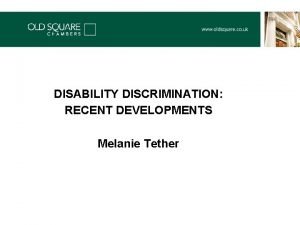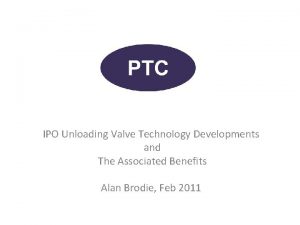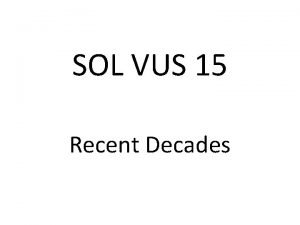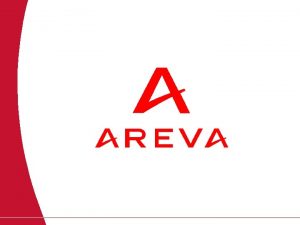Recent Developments in IPO Research Jay R Ritter
























































- Slides: 56

Recent Developments in IPO Research Jay R. Ritter University of Florida Oxford EFMA IPO Symposium

A few topics • • The international competition for new listings Why are IPOs underpriced? Do IPOs underperform in the long run? How are IPOs sold?

The international competition for new listings

The vast majority of IPOs list in the issuer’s home market Every year from 1995 -2006, 90 -97% of IPOs list in the issuer’s home market Why?

Demand is local Some IPOs list in more than one market (cross-listing) Mainly very large IPOs, including privatizations Cross-listings have been rapidly declining, partly due to better clearing mechanisms in the EU Many Chinese companies list abroad (Singapore, London, New York) For attracting foreign investors, a Hong Kong listing is common

Some moderate-size and small firms list abroad rather than at home Hong Kong’s market share has been rising AIM’s market share has been rising The market shares of the NYSE and NASDAQ have been falling Some blame the Sarbanes-Oxley (SOX) Act of 2002

Number of Offerings and Average First-day Returns on US IPOs, 1980 -2007



Singapore has become a major center for small Chinese companies to go public Year 2004 2005 2006 Number of Foreign IPOs in Singapore All From China and Hong Kong 14 29 32 13 24 29 The median proceeds in 2006 = $25. 6 million

Market conditions for IPOs fluctuate between hot and cold French IPO volume has fluctuated between 4 and 121 IPOs per year German IPO volume has fluctuated between zero and 175 IPOs per year Italian IPO volume has fluctuated between zero and 42 IPOs per year UK IPO volume has fluctuated between 12 and 264 IPOs per year

Number of Offerings and Average First-day Returns on French IPOs, 1983 -2007

Number of Offerings and Average First-day Returns on German IPOs, 1980 -2007

Number of Offerings and Average First-day Returns on Italian IPOs, 1985 -2007

Number of Offerings and Average First-day Returns on UK IPOs, 1980 -2007

The number of U. S. IPOs (not including ADRs) has fluctuated between 63 to over 600 offerings per year

Investor protection vs. excessive regulation Jensen and Meckling (1976 JFE) Investors price protect themselves Shleifer and Vishny (1997 JF) La Porta, Lopez-de-Silanes, Shleifer, and Vishny (1998 JPE) Laws and their enforcement matter

Why are IPOs underpriced?



Asymmetric Information-based Explanations for Underpricing The “winner’s curse” or “Groucho Marx theorem” (Rock (1986)) If you are unsure of the fair value of shares being sold, and there is excess demand, the most optimistic investors are likely to get the shares Thus, conditional on getting the shares, you find out that you are probably overoptimisitic The need to give institutions an incentive to investigate a company and buy its shares (Benveniste and Spindt (1989))

These are good explanations if we were seeking to explain why, on average, underpricing is 5 -10% These are not good explanations when we are trying to explain why underpricing is 15% or more

Underpricing and allocations are related There are three frameworks for viewing discretion in allocations The information acquisition view (Benveniste and Spindt), in which underwriters favor regular investors who provide information about demand, resulting in more accurate pricing The “pitchbook” view, in which underwriters seek out buy-and-hold investors The rent-seeking view, in which underwriters trade money left on the table for quid pro quos (commission business) Biased analyst recommendations appeal to issuing firms and make them willing to leave money on the table

IPO Underpricing • Is it equilibrium compensation for risk-bearing or providing information? • Is it excessive, with rent-seeking behavior common?

Loughran and Ritter’s (2004 FM) issuer objective function: α 1·IPO Proceeds + α 2·Proceeds from Future Sales + (1 -α 2)·Side Payments

Why do issuers put up with severe underpricing? On internet IPOs, underwriters knew they were overpriced But why did their analysts put out “buy” recommendations? Issuer stupidity The publicity is worth it Capital can be raised in a follow-on offering Prospect theory When people get good news about their wealth increasing, they don’t bargain as hard at the pricing meeting Analyst lust and spinning Issuers seek out underwriters where influential analysts will be bullish Spinning of hot IPOs to executives

Scandals (SLAC): Spinning: Allocating hot IPOs to the personal brokerage accounts of top executives in return for company business Laddering: Requiring the purchase of additional shares in the aftermarket in return for IPOs Analyst conflicts of interest: Giving “buy” recommendations in return for underwriting and M&A business Commission business in return for IPOs: Underwriters allocated IPOs primarily to investors that generated soft dollar commissions on other trades

Academic Evidence on SLAC Problems : Spinning: Xiaoding Liu and Jay Ritter’s “Corporate Executive Bribery: An Empirical Analysis” Laddering: Grace Hao’s 2007 JFE paper “Laddering in Initial Public Offerings” Analyst conflicts of interest: Mike Cliff and David Denis’s 2004 JF paper and Liu-Ritter paper Commissions: Jon Reuter’s 2006 JF paper

Example of spinning: Salomon Smith Barney's allocations of IPOs to Bernie Ebbers IPO Date Mc. Leod 6/96 Tag Heuer 9/96 Qwest Communications 6/97 TV Azteca 8/97 Box Hill Systems 9/97 Nextlink Communications 9/97 China Mobile HK 10/97 Metromedia Fiber 10/97 Teligent 11/97 Earthshell 3/98 Rhythms Netconnection 4/99 Juno Online 5/99 Juniper Networks 6/99 Focal Communications 7/99 Williams Communications 10/99 Radio Unica 10/99 Chartered Semiconductor 10/99 UPS 11/99 KPNQwest 11/99 Tycom Ltd 7/00 Signalsoft 8/00 Ebber's Shares Offer Price Market Price 200, 000 5, 000 205, 000 1, 000 5, 000 200, 000 2, 000 100, 000 30, 000 12, 500 10, 000 5, 000 35, 000 4, 000 5, 000 20, 000 7, 500 5, 000 $20. 00 $19. 55 $22. 00 $18. 25 $15. 00 $17. 00 $30. 50 $16. 00 $21. 50 $21. 00 $13. 00 $34. 00 $13. 00 $23. 00 $16. 00 $20. 00 $50. 00 $20. 81 $32. 00 $17. 00 $25. 13 $20. 00 $28. 00 $19. 19 $20. 62 $23. 25 $28. 00 $21. 38 $25. 63 $23. 56 $69. 13 $11. 63 $98. 88 $19. 50 $28. 06 $27. 44 $33. 19 $67. 38 $29. 81 $37. 00 $21. 88 First-day Profit $1, 026, 000 $2, 250 $1, 230, 000 $900 $28, 100 $1, 250, 000 -$5, 000 $538, 000 $123, 900 $32, 000 $481, 300 -$13, 700 $324, 400 $32, 500 $177, 100 $45, 800 $66, 000 $34, 800 $180, 000 $37, 500 $24, 400

“Corporate Executive Bribery: An Empirical Analysis” (joint work with Xiaoding Liu) • IPOs in which the executives are being spun are underpriced about 18% more than other IPOs, holding everything else constant • Firms that are involved in spinning are much less likely to switch underwriters for their next public equity offering (5% vs. 31%)

Analyst coverage

Analyst Coverage Is Bundled with Bookbuilding Degeorge, Derrien, and Womack (July 2007 RFS) “Analyst Hype In IPOs: Explaining the Popularity of Bookbuilding”

What are the most important qualities of a good analyst? a) Accurate earnings forecasts b) Timely buy and sell recommendations c) Insightful written reports d) Setting up meetings with management e) Accessibility/responsiveness of phone calls f) Industry knowledge


Example of kickbacks with commissions: Credit Suisse First Boston (CSFB) received commission business equal to as much as 65% of the profits that some investors received from certain hot IPOs, such as the December 9, 1999 IPO of VA Linux The VA Linux IPO involved 5. 06 million shares Offer price: $30. 00 Closing market price: $239. 25 Capital gain: $209. 25 Gross spread: $2. 10 If the investor then traded shares to generate commissions of one-half of this profit the total underwriter compensation per share was $2. 10 plus $104. 625, or $106. 725

According to paragraph 58 of the SEC’s January 22, 2002 settlement with CSFB, an institutional customer that had received a 12, 500 share allocation of VA Linux from CSFB paid CSFB at least $565, 000 by engaging in the following transactions:

Where were the regulators during the internet bubble? At first…


But then…


And then…


Long-run performance of IPOs

While IPOs tend to go up on the first day of trading, in the long run, on average they have tended to underperform. But there is a strong cross-sectional pattern in the U. S. : IPOs that had annual sales of less than $50 million severely underperform, whereas those that had achieved annual sales of $50 million don’t underperform. Buy-and-hold stock returns are skewed: there are some big winners, but most stocks underperform. This is especially true with young companies, where there is even greater right skewness.

Annual returns in the five years after going public for U. S. 6, 973 IPOs from 1970 -2003. Style-matched firms match on market cap and book-to-market.


Many of the AIM listings have annual sales below $50 million, a category in which U. S. IPOs have underperformed in the past.

How are IPOs sold?

Fixed Price Offerings Bookbuilding Information acquisition (Benveniste and Spindt (1989)) Agency problems (Loughran and Ritter (2002, 2004)) Auctions Hybrid Mechanisms

Pricing and Allocation • Is the offer price set before or after information about the state of demand is acquired? • Are shares allocated in a discriminatory or nondiscriminatory manner (favoritism vs. pro rata)?

August 1992, Shenzhen: Before the rioting started, crowds waited for the new share subscription forms 51


Google’s IPO • Andreas Trauten’s paper this morning “Why the Google IPO might stay exotic– an experimental analysis of offering mechanisms” • File price range of $108 -135/share • Auction result: $85/share offer price • Closing first-day price of $100. 33/share

What went wrong? • Out of equilibrium disclosure strategy • First post-IPO earnings announcement on Oct. 21, 2004, with revenue up 105% from the yearearlier quarter: price jumped 15. 4% • Second post-IPO earnings announcement on Feb. 1, 2005 , with revenue up 101% from the year-earlier quarter: price jumped 7. 3%

Summary Hot and Cold markets will continue Issuers still put up with underpricing Long-run underperformance is restricted to companies going public with less than $50 million in annual sales In the U. S. , auctions are becoming (slightly) more common, although bookbuilding has become the dominant method internationally

Summary (continued) Regulatory reform has changed the game a little Spinning has been nearly eliminated Laddering continues to occur Analyst lust will continue Commission business in return for IPOs is still allowed Underwriters still have an incentive to underprice The academic literature still focuses too much on asymmetric information models rather than agency models
 Jay ritter ipo
Jay ritter ipo Recent developments in ict
Recent developments in ict Recent developments in object detection
Recent developments in object detection Jay r ritter
Jay r ritter Peggy borum uf
Peggy borum uf Ipo research paradigm
Ipo research paradigm Conceptual framework input process output template
Conceptual framework input process output template Karl ritter aportes y obras
Karl ritter aportes y obras Alexander von humboldt and carl ritter
Alexander von humboldt and carl ritter Gedicht für 6. klasse
Gedicht für 6. klasse Vakwerken
Vakwerken Prinzessin leia goldener bikini
Prinzessin leia goldener bikini Andrea ritter
Andrea ritter Ritter 1991
Ritter 1991 Cyril ritter
Cyril ritter Ritter corporation's accountants prepared
Ritter corporation's accountants prepared Cultural development of sahelanthropus tchadensis brainly
Cultural development of sahelanthropus tchadensis brainly Chartered developments
Chartered developments Political developments in the early republic
Political developments in the early republic Huron creek
Huron creek Chapter 11 political developments in the early republic
Chapter 11 political developments in the early republic Surface developments
Surface developments Gte milano
Gte milano In the colonial era developments such as the new england
In the colonial era developments such as the new england Target developments
Target developments Patterns of development cause and effect
Patterns of development cause and effect Pattern development in technical drawing
Pattern development in technical drawing Tca developments
Tca developments Democratic developments in england
Democratic developments in england Cplim
Cplim Name
Name Medical development international
Medical development international American grassfed association standards
American grassfed association standards How did parliament emerged victorious in medieval england
How did parliament emerged victorious in medieval england Pac chart programming
Pac chart programming Deloitte ipo roadmap
Deloitte ipo roadmap Ipo winr ditunda
Ipo winr ditunda Ipo chart c++
Ipo chart c++ Ipo chart
Ipo chart Input-process-output explanation
Input-process-output explanation Ipo chart
Ipo chart Pseudokod dan carta alir
Pseudokod dan carta alir Jetblue ipo price
Jetblue ipo price Ipo4 oxidation number
Ipo4 oxidation number Gameworks ipo
Gameworks ipo A value-returning function is
A value-returning function is Ipo chart in problem solving
Ipo chart in problem solving Chatham house foundation
Chatham house foundation Permira ipo 20b
Permira ipo 20b Square roots stock ipo
Square roots stock ipo Halogen software ipo
Halogen software ipo Mercedes glv
Mercedes glv Pdst ipo
Pdst ipo Private equity vs ipo
Private equity vs ipo Global ipo market
Global ipo market Public ipo
Public ipo Sme ipo list
Sme ipo list
